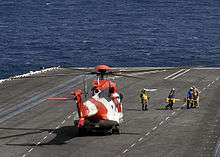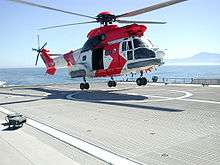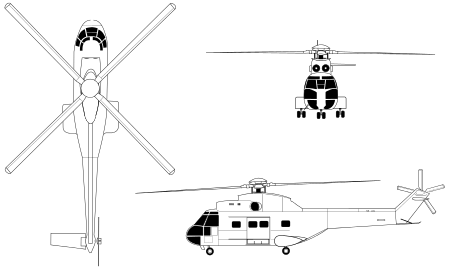Atlas Oryx
The Atlas Oryx (named after the Oryx antelope) is a medium-sized utility helicopter manufactured by the Atlas Aircraft Corporation (now Denel Aviation) of South Africa.
| Oryx | |
|---|---|
.jpg) | |
| A SAAF Atlas Oryx helicopter in flight. | |
| Role | Utility helicopter |
| National origin | South Africa |
| Manufacturer | Atlas Aircraft Corporation |
| First flight | 1986 |
| Introduction | 1987 |
| Status | In service |
| Primary user | South African Air Force |
| Produced | 1986-1991 |
| Number built | 122 |
| Developed from | Aérospatiale SA 330 Puma |
Design and development
Outside France, the SAAF was the largest user of Aérospatiale SA 330 Puma. The Oryx can trace its origins back to the Bush War. Despite the efforts of the gunship Alouette, the need for a dedicated gunship was recognized. Atlas Aircraft Corporation produced an experimental attack helicopter, the Alpha XH-1. This helicopter was used for feasibility studies and could not serve any practical purpose, this led to the more powerful XTP-1 in April 1987. Two XTP-1s were converted, and based on a Puma J airframe. Various weapons and other systems were tested on XTP-1 and paved the way for the Denel Rooivalk. However, the dynamic flight components of the XTP-1 made Atlas realise what advantages an upgraded Puma could have.
A 330L Puma, no. 177, was converted to Oryx configuration and used as a prototype and as the results exceeded all expectations the Oryx programme was launched. The sanctions era encouraged the local aviation industry to become self-sufficient in producing helicopter components and, with the knowledge to assemble pre-manufactured helicopters, led to the technical skill for producing complete Puma helicopters, should the need arise. This included complete airframes and dynamic components such as gearboxes, rotor blades and turbines and hot section parts. The engine intakes are fitted with locally produced dust filters and ensure higher efficiency and reliability.

The Oryx is an upgraded and remanufactured version of the Aérospatiale SA 330 Puma, equivalent to the Eurocopter AS332 Super Puma, and offers a performance improvement over the original, in addition to cutting the operating costs by 25 to 30%. First examples were fitted with the latest dust filters as were then in use on the SAAF Puma. These units had a moveable auxiliary air intake on the front. A newly designed dust filter was later fitted without the auxiliary air intake. Should one of the engines fail, the remaining powerplant has sufficient power for the Oryx to complete its mission. If an engine fails in flight, the management system automatically advances the power setting on the remaining engine. This ensures the Oryx sustains flight with very little crew input, during such an emergency.
The basic airframe is still that of the original Puma, but the structure was modernized by extensive use of locally produced carbon-composite materials. These materials result in an airframe that is lighter and more rugged, which increases the Oryx's endurance and maneuverability. The obvious external difference is the new modified tailboom which is slightly longer (50 cm), than the Puma.
By mid-1991, the SAAF acknowledged that the Oryx was in service, as a replacement for the Puma and Super Frelon. It was shown for the first time to the public at an open day at Potchefstroom in August '91. The Oryx is currently in service with several squadrons of the South African Air Force, with about 35 being in service.
The Oryx is a multi-role helicopter. Its main uses in the SAAF are: medium to heavy transport and communications flights, task force rapid deployment operations, fire fighting, and search & rescue missions. It can carry up to 20 fully equipped troops, or 6 wounded on stretchers with 4 attendants, or 3,000 kg freight carried in the cabin, or 4,500 kg freight on an external sling. Tasks for the South African Navy include transport, replenishment at sea, force multiplication, reconnaissance, search & rescue, etc.
Most Oryx are equipped with a 50m hydraulic hoist, rated for up to 2 personnel, for use in rescue operations. Additionally a large metal A-frame structure can be fitted in the cargo bay which allows up to 4 personnel to rappel or abseil from the aircraft simultaneously. Oryx operating from coastal squadrons are fitted with emergency flotation gear on the sponsons and nose.
Mid-life upgrade
In 2006, the SAAF initiated a mid life upgrade for 35 Oryx helicopters to extend their service life to the 2015 - 2020 timeframe.[1] Due to budgetary restrictions, the upgrade will be limited to airframe life extensions, with a limited communications and navigation upgrade.[1] It was initially planned to do a full glass cockpit upgrade.[1]
Variants

In its basic platform the design of the Oryx offers a number of advantages and this was further developed from an early stage in the program. With the Denel Rooivalk now in service, this combat helicopter will escort the Oryx in a high threat environment. However, as an interim measure an Oryx with door mounted machine guns did appear. Oryx helicopters are constantly refined and updated. A full glass cockpit is planned for a future update. The latest addition is the fitting of flare dispensers and the update of the Threat Warning Receivers.
There is an electronic warfare (stand-off communications jamming/radar jamming) version of the Oryx that is equipped with the Grinaker Systems Technologies (GST) GSY 1501 jamming system, among others. The first Oryx variant with a large log periodic antenna on the starboard side was regarded as quite an effective EW platform. This platform is capable of disrupting key communications during various stages of modern, air-, land-, and sea battles. In addition it is used as an effective training aid to the SANDF, to test their function as an effective fighting force, despite any EW methods employed against the SA Forces. A further advantage is, EW equipment in use by the SA Forces can be effectively evaluated and calibrated under simulated battlefield scenarios. One variant has its main cabin doors replaced by dome shaped antennas.
The Oryx Mk. 2 contains such a number of differences, that a different model number is used, to distinguish the type. Although, operated and flown by 22 Squadron SAAF, these helicopters were specifically build for use by the Department of Environmental Affairs and Tourism, as part of the South African National Antarctic Programme. Two Oryx helicopters have been modified for operations in the Southern Ocean and the Antarctic, for which they have been painted in the red and white colour scheme. Highly effective, de-icing equipment, of up rated specification, was the central requirement of the Mk. 2 program. The project received the go-ahead on 15 March 1996, with Lt Col K. Viljoen as project leader. The project was completed three weeks ahead of schedule and the two helicopters delivered to 22 Sqdn, during October 1997. One of the Mk. 2 Oryx helicopters was written off subsequent to a crash landing in July 2004.
Operators
Specifications

General characteristics
- Crew: Three
- Capacity: 20 fully equipped troops
- Length: 15.45 m (50 ft 8 in)
- Height: 5.14 m (16 ft 10 in)
- Empty weight: 3,600 kg (7,937 lb)
- Max takeoff weight: 8,000 kg (17,637 lb)
- Powerplant: 2 × Turbomeca Makila IA1 turboshaft engines, 1,400 kW (1,900 hp) each
- Main rotor diameter: 15.6 m (51 ft 2 in)
- Main rotor area: 191 m2 (2,060 sq ft)
Performance
- Maximum speed: 306 km/h (190 mph, 165 kn)
- Combat range: 303 km (188 mi, 164 nmi)
- Ferry range: 2,000 km (1,200 mi, 1,100 nmi)
- Service ceiling: 7,162 m (23,497 ft)
- Rate of climb: 15.25 m/s (3,002 ft/min)
Armament
- Guns: 2 × door-mounted 7.62 mm machine guns (optional; either FN MAG or Denel SS-77)
See also
Related development
- Aerospatiale Puma
Related lists
- List of attack aircraft
- List of helicopters
References
- "The South African Air Force". www.saairforce.co.za. Retrieved 2020-06-01.
- "87 Helicopter Flying School". saairforce.co.za. Retrieved 21 October 2014.
- "15 Squadron". saairforce.co.za. Retrieved 21 October 2014.
- "17 Squadron". saairforce.co.za. Retrieved 21 October 2014.
- "19 Squadron". saairforce.co.za. Retrieved 21 October 2014.
- "22 Squadron". saairforce.co.za. Retrieved 21 October 2014.
External links
| Wikimedia Commons has media related to Oryx of SAAF. |